If you’re looking for the 15 best audio interfaces delivering studio-quality sound in 2025, I recommend options like the Focusrite Scarlett Solo, M-AUDIO M-Track Duo, PreSonus AudioBox, EBXYA 2i2, MAONO USB, MOTU M2, and even versatile mixers like PUPGSIS. These models offer high-resolution audio up to 192kHz, durable builds, flexible inputs, and excellent compatibility. Continue exploring to find the perfect fit for your recording or streaming setup and release top-tier sound quality.
Key Takeaways
- Look for interfaces with 24-bit/192kHz converters for professional, high-resolution audio quality.
- Prioritize models with versatile inputs, including XLR, TRS, and MIDI, suitable for various recording setups.
- Consider compatibility across multiple devices and operating systems like Mac, Windows, iOS, and Android.
- Choose durable, portable designs with USB-C connectivity for seamless, on-the-go studio-quality recording.
- Review software bundles and advanced features like zero-latency monitoring and sound customization options.
Focusrite Scarlett Solo 3rd Gen USB Audio Interface
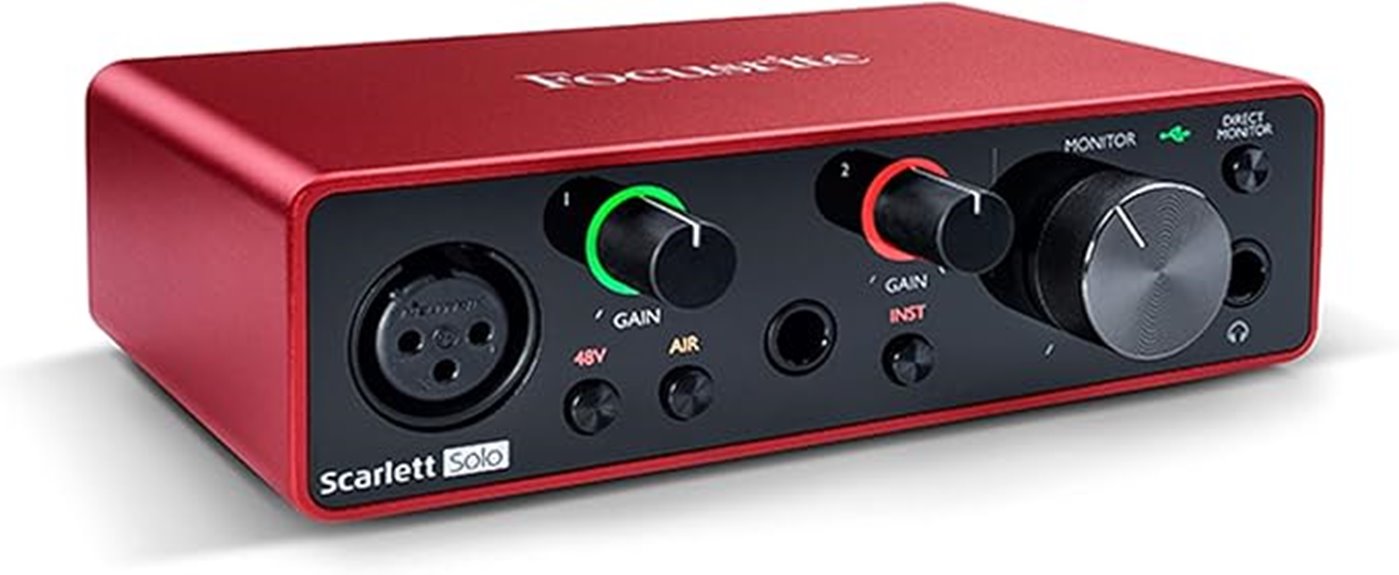
If you’re a guitarist, vocalist, or podcaster looking for a reliable, studio-quality audio interface that’s easy to use and portable, the Focusrite Scarlett Solo 3rd Gen is an excellent choice. It offers high-performance 24-bit/192kHz converters for professional sound. The upgraded mic preamp with switchable Air mode adds brightness to vocals, while high-impedance inputs handle guitars and bass without clipping. Compact and lightweight, it connects via USB-C to Mac or PC, requiring no external power. Built to withstand daily use and travel, it also includes essential software like Ableton Live Lite and Pro Tools Intro+, making it perfect for beginners and pros alike.
Best For: musicians, vocalists, podcasters, and streamers seeking a portable, easy-to-use, studio-quality audio interface for recording and live streaming.
Pros:
- High-performance 24-bit/192kHz converters deliver professional sound quality
- Compact, lightweight design with USB-C connection for easy portability and setup
- Upgraded mic preamp with switchable Air mode enhances vocal brightness and clarity
Cons:
- Occasional driver conflicts may require troubleshooting and updates
- Limited to a single microphone and instrument input, less suitable for multi-mic setups
- Some users report crackling if sample rate settings are not properly configured
M-AUDIO M-Track Duo USB Audio Interface for Recording and Streaming
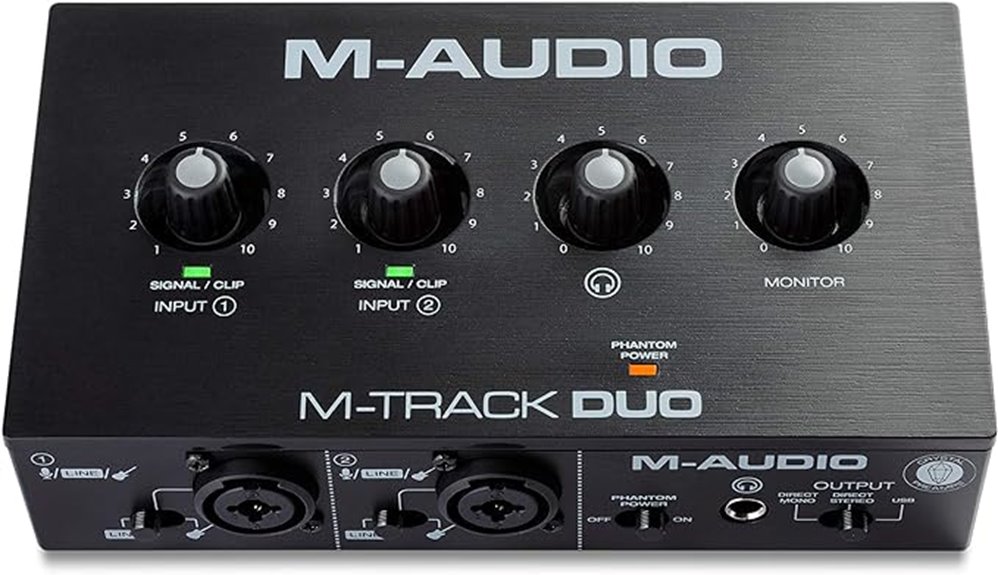
The M-Audio M-Track Duo USB audio interface stands out as an excellent choice for beginners and home studio enthusiasts who need a reliable, portable solution for recording and streaming. Its compact design and USB power make it perfect for on-the-go use. With 48 kHz resolution and two combo inputs featuring crystal preamps, it handles microphones, guitars, and line devices effortlessly. Zero-latency direct monitoring ensures smooth playback, while the included software suite offers tools like Ableton Live Lite and MPC Beats. Overall, it delivers solid sound quality, ease of use, and great value—ideal for those starting out or working in small spaces.
Best For: beginners, home studio enthusiasts, and mobile users seeking an affordable, portable USB audio interface for recording, streaming, and podcasting.
Pros:
- Compact and lightweight design ideal for portable use and small spaces
- Easy to set up and compatible with Mac, PC, iOS, and Android devices
- Includes essential software like Ableton Live Lite and MPC Beats for music creation
Cons:
- Potentiometers can be sensitive, affecting gain control precision
- Some users report sound alterations through headphone outputs at higher volumes
- Primarily made of plastic, which may feel less durable for rugged use
PreSonus AudioBox 96 USB Audio Interface

For musicians, podcasters, and mobile producers seeking a reliable, high-quality audio interface, the PreSonus AudioBox 96 USB stands out as an excellent choice. Its compact, rugged design features two combo mic/instrument inputs, MIDI I/O, and a high-loud headphone output, making it perfect for on-the-go recording. Equipped with studio-grade converters supporting up to 24-bit/96 kHz, it guarantees crisp, professional sound. The interface is plug-and-play with Mac and Windows, including Apple Silicon Macs and iOS devices. Plus, it comes with over $1000 in recording software, making it versatile for beginners and pros alike. Its durability and performance truly deliver studio-quality sound anywhere.
Best For: musicians, podcasters, and mobile producers seeking a portable, high-quality, and easy-to-use audio interface for recording on the go.
Pros:
- Compact and rugged design ideal for mobile recording environments
- Supports high-quality 24-bit/96 kHz recording and playback for professional sound
- Comes with over $1000 worth of recording software, suitable for both beginners and professionals
Cons:
- Limited to 2 channels, which may not suit larger recording setups
- Lacks built-in DSP or advanced monitoring features found in higher-end interfaces
- May require additional accessories (e.g., microphones, instruments) for complete recording setups
EBXYA 2i2 USB Audio Interface for PC Recording

Designed for beginners and mobile producers, the EBXYA 2i2 USB Audio Interface delivers plug-and-play compatibility with Mac, Windows, and mobile devices, making it a versatile choice for high-quality recordings without hassle. It works seamlessly with major DAWs like Logic Pro, Cubase, Pro Tools, and Ableton Live. Its compact design is perfect for on-the-go recording, streaming, or podcasting. Supporting 24-bit/192kHz high-resolution audio, it offers ultra-low latency and multiple inputs, including XLR/Line combo and high-impedance instrument options. With features like phantom power, loopback, and independent level controls, it combines professional sound quality with user-friendly functionality, earning positive reviews for its reliability and value.
Best For: beginners, mobile producers, and home studio users seeking an affordable, versatile, high-quality audio interface for recording, streaming, and podcasting.
Pros:
- Plug-and-play compatibility with Mac, Windows, and mobile devices for easy setup
- Supports high-resolution 24-bit/192kHz audio with ultra-low latency for professional-quality sound
- Includes multiple input/output options, phantom power, loopback, and portable design for versatile use
Cons:
- XLR gain may only activate at high levels, requiring adjustments for proper input volume
- Monitor output and phantom power switch issues reported by some users, indicating occasional hardware inconsistencies
- Limited advanced features, making it less suitable for high-end professional studio workflows
MAONO USB Audio Interface for PC with XLR Input

If you’re looking for a budget-friendly audio interface that doesn’t compromise on quality, the MAONO PS22 Lite is a top contender. It records in high resolution at 24-bit/192kHz with a dynamic range of 106dB, capturing clear, realistic sound. Its XLR input supports condenser and dynamic mics with up to 56dB preamp gain and 48V phantom power, perfect for vocals, podcasts, and studio work. The device supports Mac, Windows, iPads, Android, and smartphones with easy plug-and-play setup. Compact and durable, it features intuitive controls, headphone monitoring, and USB-C connectivity for stable, fast data transfer, making it ideal for content creators on the go.
Best For: content creators, podcasters, and musicians seeking an affordable yet high-quality audio interface for versatile recording needs.
Pros:
- High-resolution recording at 24-bit/192kHz with a wide dynamic range for clear sound
- Supports a variety of devices including Mac, Windows, iPads, Android, and smartphones with plug-and-play ease
- Durable, compact design with intuitive controls and USB-C connectivity for stable data transfer
Cons:
- Occasional crackling and popping issues that may require driver updates or switching connections
- Limited features such as absence of advanced options like ADAT ports or external power supply
- Some users report internal hardware faults, affecting long-term reliability
Ueteto Audio Interface for Guitar, Portable Sound Card for Smartphones and Tablets

The Ueteto Audio Interface stands out as an affordable, portable option perfect for beginners who want to record guitar directly into their smartphones or tablets. It’s compact, easy to use, and connects via USB-C or Lightning, supporting iOS and Android devices without needing drivers. While it offers good sound quality and low latency for simple recordings, it has limitations, such as compatibility issues with apps like GarageBand and no FX/THRU button, which affects signal routing. Some users report lag or recognition problems over time. Overall, it’s a budget-friendly tool suitable for basic recording, especially for those just starting out.
Best For: beginners looking for an affordable, portable way to record guitar directly into their smartphones or tablets without complex setup or editing capabilities.
Pros:
- Compact, lightweight, and highly portable for on-the-go recording
- Easy plug-and-play operation with no drivers needed
- Supports high-quality audio and low latency for basic recording tasks
Cons:
- Compatibility issues with certain apps like GarageBand and limited routing options due to no FX/THRU button
- Potential lag, recognition problems, or device dropouts over time
- Durability concerns and limited long-term reliability, with some users experiencing device failure
XTUGA USB Audio Interface for PC with Microphone Jack and Low Latency

For home studio enthusiasts and beginner musicians seeking reliable, studio-quality sound, the XTUGA Q-12 USB Audio Interface offers an excellent solution. It’s designed for PC recording and works seamlessly with recording software. You can sing, play guitar, or bass, thanks to its versatile inputs, including a 3-pin XLR microphone jack with 48V phantom power and an additional 3.5mm mic input. Its plug-and-play setup ensures ultra-low latency, and independent volume controls help you fine-tune each channel. With high-quality 16-bit/48 kHz conversion, this interface delivers clear, professional sound, making it a perfect choice for home studios and live performances alike.
Best For: home studio enthusiasts, beginner musicians, and live performers seeking reliable, studio-quality sound with easy setup and versatile input options.
Pros:
- Plug & Play design with ultra-low latency for seamless recording and playback
- Supports professional-grade 16-bit/48 kHz audio quality for clear sound
- Includes a 3-pin XLR microphone input with +48V phantom power and independent volume controls
Cons:
- Limited to 16-bit/48 kHz resolution, which may be insufficient for high-end professional recording
- May require real-time adjustments for optimal sound levels during use
- Compact design might lack some advanced features found in higher-end interfaces
2×2 USB Audio Interface with Phantom Power and High-Fidelity Sound
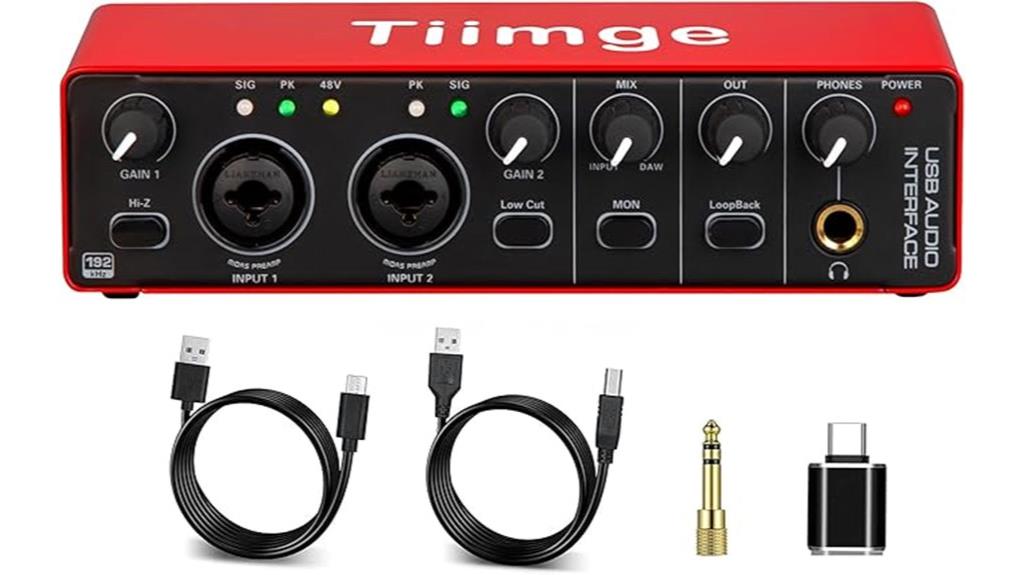
A 2×2 USB audio interface with phantom power and high-fidelity sound is an excellent choice for musicians, podcasters, and producers seeking professional-level recordings. It supports both Windows and Mac OS, working seamlessly with popular DAWs like Pro Tools, Ableton, and Cubase without needing driver downloads—just plug and play. With 24-bit/192kHz recording quality and 48V phantom power, it captures detailed audio and powers condenser mics. Its compact metal design features two combo inputs for microphones or instruments and two main outputs for monitors or speakers. This versatile interface offers exceptional sound clarity, ease of use, and compatibility for a wide range of recording needs.
Best For: musicians, podcasters, and producers seeking high-quality, portable audio recording solutions compatible with both Windows and Mac OS.
Pros:
- Supports 24-bit/192kHz high-fidelity recording for detailed sound quality
- Plug-and-play compatibility with major DAWs like Pro Tools, Ableton, and Cubase without drivers
- Compact, durable metal design with versatile inputs and outputs for various recording setups
Cons:
- Rated 4.0 out of 5 stars, indicating some users may experience issues or limitations
- Limited to 2 input channels, which may not suffice for complex multi-mic setups
- Does not include additional features like built-in effects or advanced monitoring options
Universal Audio Volt 1 USB Recording Studio Audio Interface
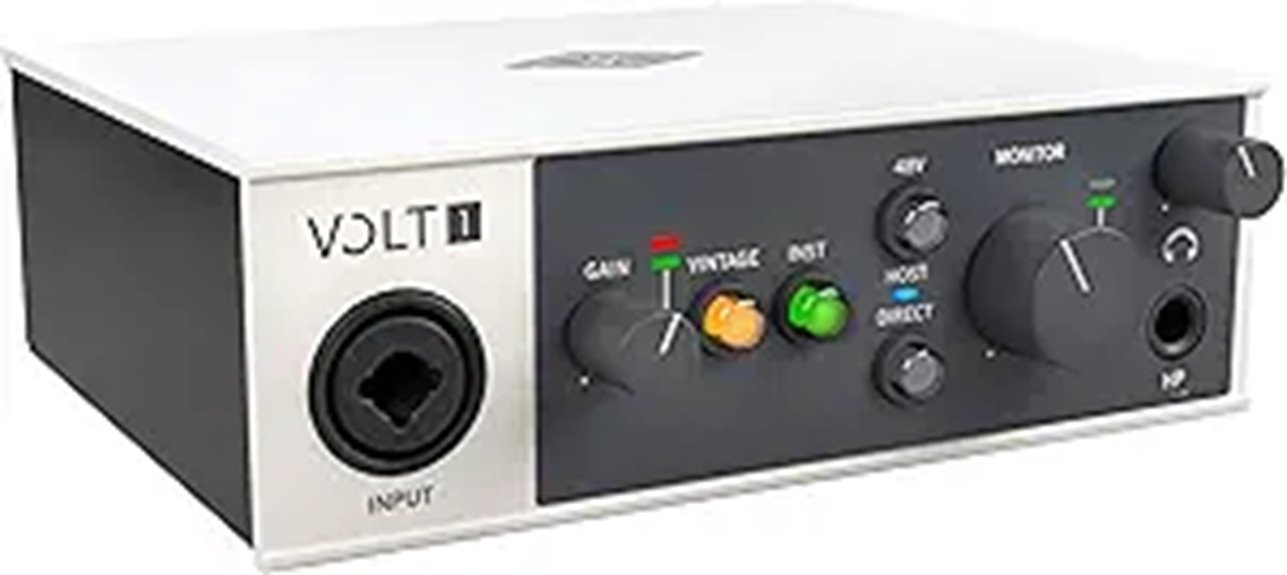
If you’re looking for a portable yet professional-quality audio interface, the Universal Audio Volt 1 USB Recording Studio Audio Interface stands out as an excellent choice. It features UA’s classic 610 preamps and supports up to 24-bit/192 kHz for studio-grade sound. Its compact, sturdy design includes solid knobs, MIDI I/O, phantom power, zero-latency monitoring, and a direct-drive headphone output, all weighing just 1.2 pounds. Compatible with Mac, PC, iPad, and iPhone via USB 2.0, it’s perfect for on-the-go recording, podcasts, or practice. Its software bundle, including the LUNA DAW and industry-leading UAD plug-ins, makes it versatile for both beginners and professionals.
Best For: solo musicians, podcasters, and mobile content creators seeking a portable, professional-quality audio interface for on-the-go recording and streaming.
Pros:
- Compact, lightweight design ideal for portability and travel
- Supports high-quality 24-bit/192 kHz recording with vintage preamp emulation
- Includes a comprehensive software bundle with DAW, plug-ins, and instruments
Cons:
- Lacks a USB-C port, requiring compatible cables for newer devices
- Software control options and routing can be limited or challenging for some users
- Occasional reports of noise or connectivity issues over time
PreSonus Studio 24c 2×2 USB Audio Interface with DAW Software
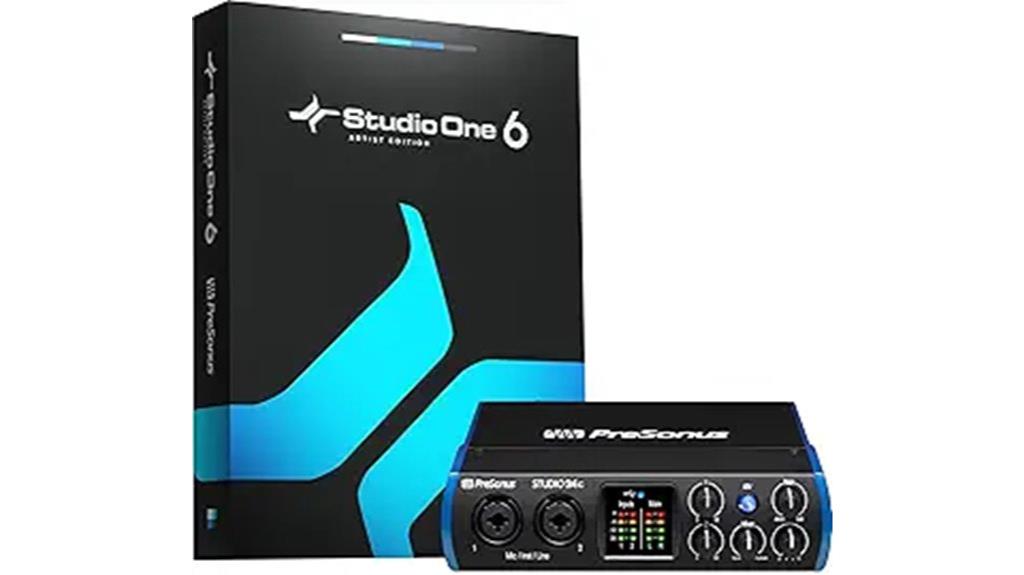
The PreSonus Studio 24c 2×2 USB Audio Interface stands out as an excellent choice for musicians and content creators seeking high-quality sound in a compact, mobile package. It delivers 24-bit/192 kHz resolution with two XMAX-L mic preamps, offering up to 80 dB of gain for clear, natural recordings. Its rugged design and bus-powered USB-C connection make it perfect for studio or on-the-go use. Included DAW software like Studio One 6 and Studio Magic enhance usability for beginners and pros alike. With professional metering, versatile inputs, and high-quality converters, the Studio 24c provides studio-grade sound in a portable, user-friendly interface ideal for a wide range of recording scenarios.
TONOR 202 Audio Interface for Recording and Streaming

With its vibrant RGB lighting and intuitive controls, the TONOR TX510 stands out as an excellent choice for content creators who want professional-grade sound combined with stylish design. This interface delivers studio-quality audio with clear, precise reproduction, ideal for streaming, podcasting, and recording. Its versatile 2 XLR and 6.35mm combo inputs allow multiple sources to connect simultaneously, while the INST button simplifies switching between instruments and vocals. The user-friendly controls and indicator lights make adjustments effortless. Plus, the colorful lighting adds visual flair to any setup. Compact and compatible with Windows and macOS, the TX510 is a reliable, high-performance option for creators seeking top-tier sound.
Best For: content creators, streamers, and podcasters seeking studio-quality sound with stylish, user-friendly features.
Pros:
- Delivers professional-grade, clear and precise audio reproduction suitable for various recording needs.
- Vibrant RGB lighting and intuitive controls enhance user experience and visual appeal.
- Versatile input options (2 XLR and 6.35mm combo) support multiple simultaneous audio sources.
Cons:
- Slightly larger size may require dedicated space on a desk.
- Limited to Windows and macOS, not compatible with other operating systems.
- Customer rating of 4.1 stars suggests some users may experience minor issues or desired additional features.
PreSonus AudioBox GO USB-C Audio Interface

For musicians and producers seeking a portable, budget-friendly audio interface, the PreSonus AudioBox GO USB-C stands out as an excellent choice. Weighing just 8.2 ounces and measuring 3.37 x 4.37 x 1.75 inches, it fits easily into guitar cases or laptop bags, making it perfect for mobile recording. Despite its compact size, it offers professional features like studio-grade 24-bit/96 kHz converters, a PreSonus XMAX-L preamp, and multiple inputs—mic, instrument, and line. With balanced outputs, a high-power headphone jack, and compatibility with Android, Apple, Windows, and macOS devices, it delivers studio-quality sound anywhere.
Best For: musicians, producers, and content creators seeking a portable, affordable, and professional-quality audio interface for mobile and home recording.
Pros:
- Compact and lightweight design for easy portability
- Studio-grade 24-bit/96 kHz converters for high-quality sound
- Versatile inputs including mic, instrument, and line with a PreSonus XMAX-L preamp
Cons:
- Limited to bus power, which may affect use with low-power devices
- No built-in DSP or effects for real-time processing
- Might lack advanced features needed for complex studio setups
MAONO Audio Interface with 10-Channel Mixer and Sound Pads

If you’re looking to elevate your live streaming, podcasting, or music production, the MAONO AME2 stands out thanks to its integrated 10-channel mixer and sound pads, making it a versatile choice. It offers high-quality preamps with phantom power, ultra-low noise gain, and a 32-bit chipset with DENOISE for clear sound. Compatible with most analog microphones and supporting multiple devices like PCs, smartphones, and tablets, it also features extensive sound customization options, including reverb modes, auto-tune, and adjustable tone controls. The 11 customizable sound pads let you create unique audio atmospheres, making this interface perfect for content creators seeking professional results.
Best For: content creators, streamers, and musicians seeking an all-in-one audio interface with versatile sound customization and professional audio quality.
Pros:
- Excellent sound quality with high-quality preamps, ultra-low noise gain, and DENOISE chipset for clear audio
- Extensive customization options including reverb modes, auto-tune, adjustable tone controls, and 11 sound pads for personalized atmospheres
- Supports a wide range of devices and microphones, making it highly versatile for live streaming, podcasting, and music production
Cons:
- Limited to one XLR microphone input, which may restrict multi-mic setups
- Small controls and sliders can be difficult to adjust precisely, affecting user experience
- Higher price point and some build quality concerns may be off-putting for budget-conscious users
MOTU M2 USB-C Audio Interface
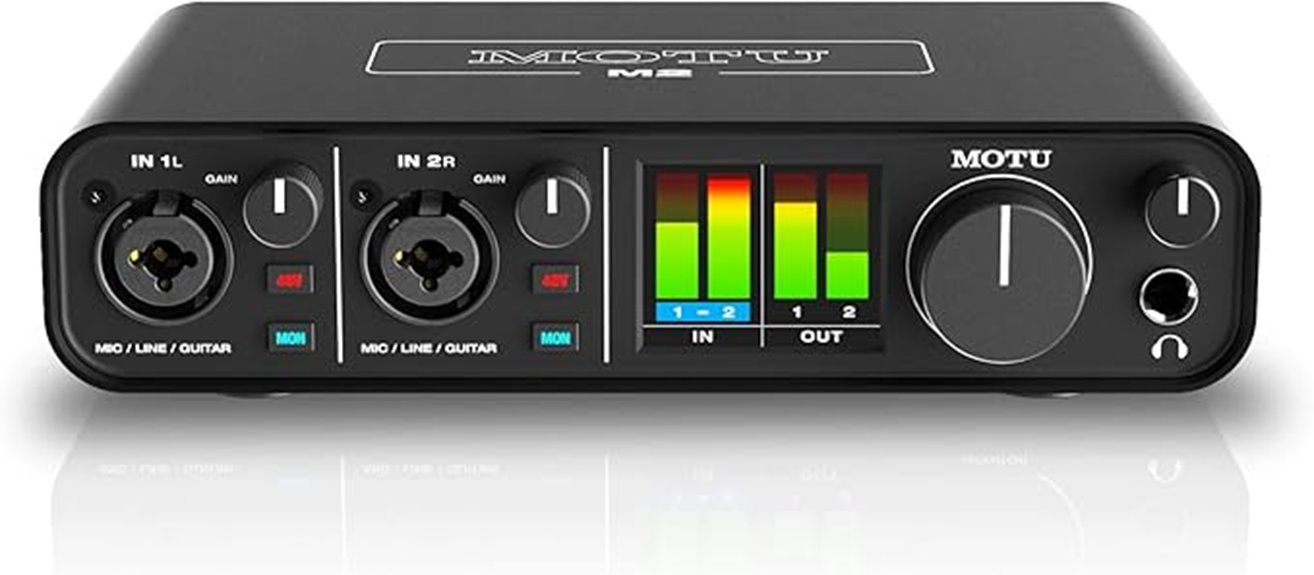
Looking for a compact yet professional audio interface that delivers exceptional sound quality? The MOTU M2 USB-C fits the bill perfectly. It offers 24-bit/192kHz audio, two high-quality preamps, and hardware monitoring, making it ideal for studio work or streaming. Its small design—just over 7 inches wide—packs a punch with USB-C connectivity compatible with macOS, Windows, and iOS. With a user rating of 4.5 stars, it’s highly regarded despite being discontinued. Available online, it’s a reliable choice for those seeking professional-grade sound in a portable package, backed by solid support and warranty options.
Best For: musicians, streamers, and home studio enthusiasts seeking a compact, professional-grade audio interface with excellent sound quality.
Pros:
- Delivers 24-bit/192kHz high-resolution audio for professional sound clarity
- Compact design with USB-C connectivity compatible across macOS, Windows, and iOS
- Equipped with 2 high-quality preamps and hardware monitoring for accurate recording
Cons:
- Discontinued by the manufacturer, which may limit future support or updates
- Limited to 2-in/2-out configuration, which might not suit complex studio setups
- May be priced higher compared to entry-level audio interfaces with similar features
PUPGSIS Gaming Audio Mixer with Microphone Inputs and Effects
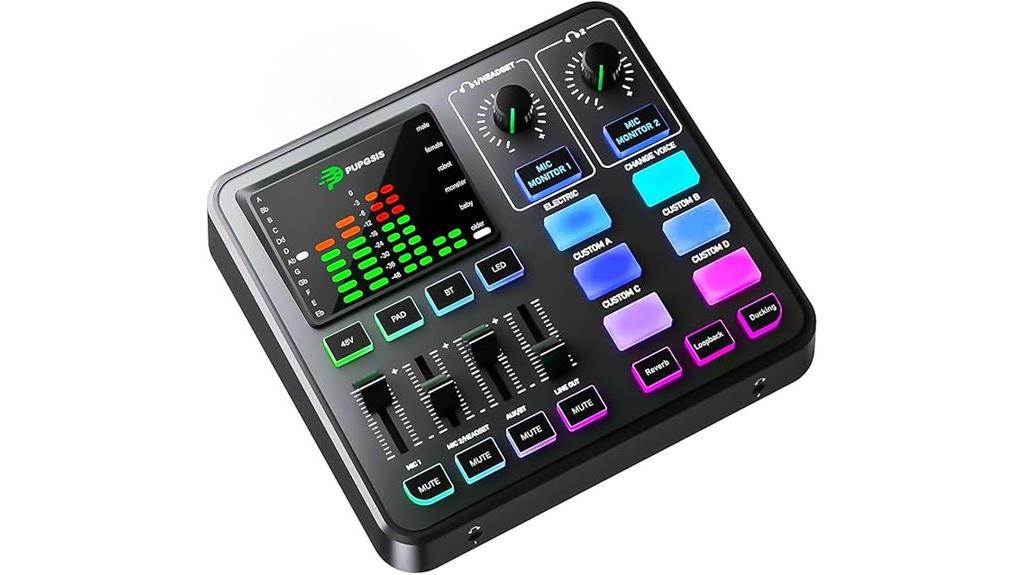
The PUPGSIS Gaming Audio Mixer stands out with its versatile microphone inputs and built-in effects, making it an excellent choice for streamers, gamers, and content creators who need professional-grade sound. It features a high-quality preamp with 48V phantom power, ensuring compatibility with XLR microphones for clear audio. The mixer offers six voice-changing modes, four customizable soundpads, and two reverb presets, allowing for personalized sound effects. Its intuitive controls include four independent volume faders and a clear display, simplifying adjustments. With real-time monitoring, zero latency feedback, and support for multiple devices, it’s a powerful, user-friendly tool for elevating your audio experience.
Best For: content creators, streamers, and gamers seeking professional-grade audio with versatile effects and easy control.
Pros:
- High-quality sound with professional preamp and 48V phantom power for XLR microphones
- Multiple voice-changing modes, soundpads, and reverb presets for personalized audio effects
- User-friendly interface with independent volume faders and real-time monitoring for seamless adjustments
Cons:
- May require some technical knowledge to fully utilize advanced features
- Limited to three microphone inputs, which might be insufficient for larger groups
- Potentially bulky design, making it less portable for on-the-go use
Factors to Consider When Choosing Audio Interfaces
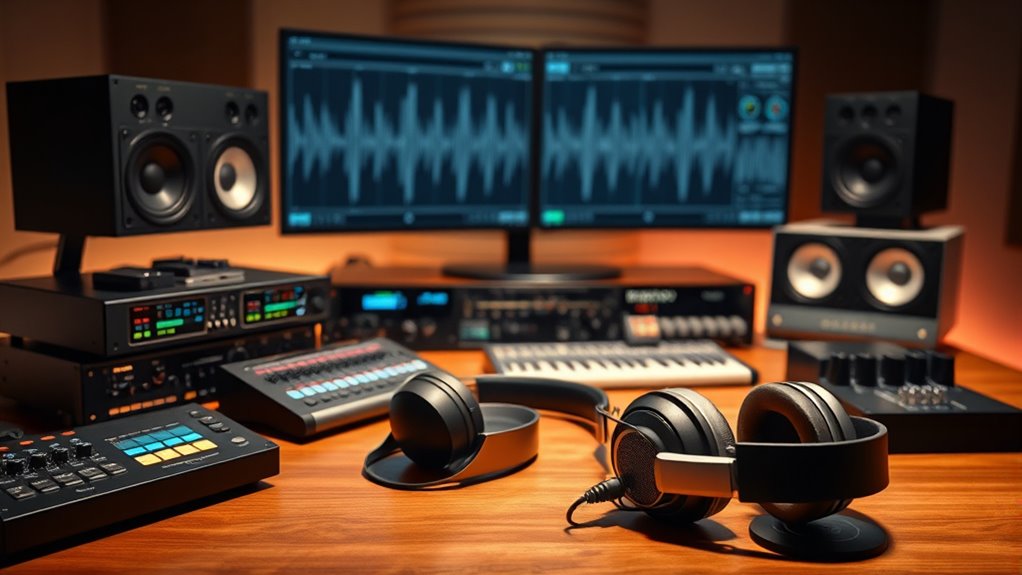
When selecting an audio interface, I consider how well it works with my devices and the variety of input and output options it offers. I also pay attention to sound quality standards, portability, and whether the software support is dependable. These factors help me find an interface that fits my needs and ensures smooth recording sessions.
Compatibility With Devices
Choosing the right audio interface requires ensuring it’s compatible with your devices, so it works smoothly without headaches. First, check that it supports your operating system, whether macOS, Windows, iOS, or Android. Make sure the connection type—USB, Thunderbolt, or USB-C—is compatible with your computer or mobile device’s ports. Also, verify if the interface needs drivers and if those drivers are up-to-date and compatible with your software version. It’s important to confirm that it can support your peripherals, like microphones, instruments, or MIDI controllers, through appropriate inputs and power options. Finally, consider whether the device is plug-and-play or if it requires additional setup, ensuring seamless integration with your existing hardware and software environment. Compatibility is key to a hassle-free experience.
Input and Output Options
Selecting an audio interface involves carefully evaluating its input and output options to match your recording needs. The number and types of inputs, such as XLR, TRS, or combo jacks, determine how many sources you can connect at once, whether microphones, instruments, or line-level devices. Outputs should include balanced connections for studio monitors and a dedicated headphone jack for accurate monitoring. If you plan to integrate external hardware like MIDI controllers, verify the interface supports those connections. Multiple output channels allow for complex routing and mixing, essential for versatile setups. Finally, consider compatibility with your devices—support for switching between line, instrument, or mic levels ensures flexible connectivity, making your workflow smoother and more efficient.
Sound Quality Standards
Sound quality is the foundation of any great recording setup, and it depends on several key factors. I look for interfaces supporting at least 24-bit resolution and a sample rate of 96 kHz or higher for professional fidelity. Low total harmonic distortion (THD) and a high signal-to-noise ratio (SNR), typically above 100 dB, are essential for clarity and dynamic range. High-quality converters, like 24-bit/192 kHz models, capture more detailed audio, while premium preamps reduce noise and preserve nuances in vocals and instruments. Additionally, well-designed interfaces minimize latency and interference, ensuring clean recordings and playback. These standards are vital for achieving the studio-quality sound I aim for, making them key considerations when choosing an audio interface.
Portability and Size
When I need to record on the go or in different environments, portability and size become top priorities. A lightweight, portable interface—often under 2 pounds—makes it easy to carry in a backpack or travel setup. Compact designs, usually under 6 inches, save space and simplify transport. While smaller interfaces may have fewer inputs and outputs, they focus on ease of use and convenience. USB-C or USB-A connectivity ensures quick, reliable digital connections without external power sources, making setups straightforward. The size and portability also affect durability and suitability, whether I’m working in a studio, live setting, or field recording. Choosing a compact, lightweight interface helps me stay flexible and ready to record wherever inspiration strikes.
Software and Driver Support
Choosing an audio interface with good software and driver support is essential for guaranteeing stable performance and smooth workflow. I look for interfaces with compatible, regularly updated drivers for my OS, whether macOS, Windows, or iOS, to avoid stability issues. It’s also important that the software supports my preferred DAWs like Ableton, Pro Tools, or Logic Pro, for seamless integration. I prefer interfaces with dedicated control panels or companion apps, making configuration and firmware updates straightforward. Low-latency monitoring and real-time effects processing are indispensable, especially for live recording or streaming. Finally, I prioritize brands committed to ongoing driver updates and responsive support, which helps maintain performance and resolve compatibility problems over time. Good support ensures my setup stays reliable and efficient.
Frequently Asked Questions
Which Audio Interface Offers the Best Compatibility With Both Mac and Windows?
I recommend the Universal Audio Apollo Twin X for top compatibility with both Mac and Windows. It’s known for seamless integration, reliable drivers, and excellent sound quality across operating systems. I’ve found it works effortlessly on both platforms without major issues, making it a versatile choice. If you want a hassle-free experience and professional-grade sound, this interface is a solid investment that supports your creative workflow regardless of your OS.
How Do Latency Levels Vary Between Entry-Level and Professional-Grade Audio Interfaces?
Latency levels differ markedly between entry-level and professional-grade audio interfaces. I’ve noticed that entry-level models often introduce noticeable delays, which can disrupt recording and mixing. In contrast, professional interfaces minimize latency to near-zero, allowing real-time performance without hiccups. This difference impacts your workflow tremendously—lower latency means smoother recordings and editing. So, if you’re serious about quality, investing in a high-end interface is worth it to keep latency virtually invisible.
What Are the Most Important Features for Live Streaming Versus Studio Recording?
For live streaming, I prioritize low latency, reliable connectivity, and easy setup, so I can stay engaged without interruptions. When it comes to studio recording, I look for high audio quality, multiple input/output options, and excellent preamps to capture every detail. Both require durability and good software compatibility, but my focus shifts depending on whether I need quick responsiveness or pristine sound fidelity.
Can I Upgrade or Expand My Audio Interface’s Inputs and Outputs Later?
Did you know that over 60% of audio professionals upgrade their interfaces within two years? Yes, you can typically expand or upgrade your audio interface’s inputs and outputs later, but it depends on the model. Many interfaces offer additional modules or connect via ADAT or Thunderbolt. Just check compatibility first to guarantee seamless integration, and you’ll have a flexible setup that grows with your needs.
How Do I Determine the Best Audio Quality Specifications for My Needs?
To determine the best audio quality specs for my needs, I focus on my intended use—whether recording vocals, instruments, or mixing. I look for interfaces with high sample rates (at least 96kHz), low latency, and high-resolution analog-to-digital converters (24-bit or higher). I also read reviews and compare specs to make certain the interface can handle my project demands without sacrificing clarity or detail.
Conclusion
Choosing the right audio interface can seem overwhelming, but remember, it’s like picking the perfect tool for your needs. Whether you prioritize simplicity or advanced features, there’s a great option out there. Think of it like selecting a camera lens—you wouldn’t use a wide-angle for portraits, right? By matching your goals with the right interface, you’ll get studio-quality sound every time, making your recordings and streams stand out effortlessly.










